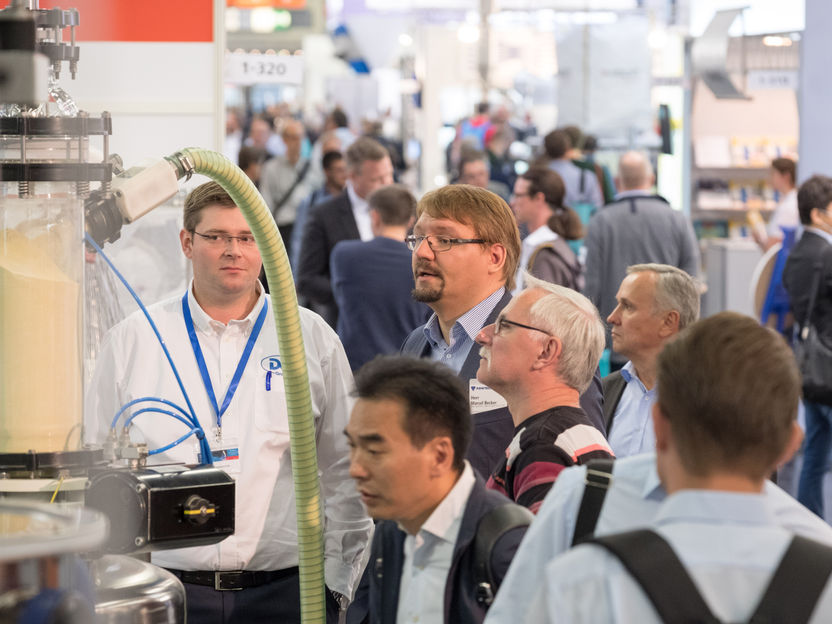En route to custom-designed natural products
Researchers decode structure and function of docking domains in the biosynthesis of peptide natural products
Microorganisms often assemble natural products similar to industrial assembly lines. Certain enzymes, non-ribosomal peptide synthetases (NRPS) play a key role in this process. Biotechnologists at Goethe University have now been able to discover how these enzymes interact with each other. This brings them one step closer to their goal of engineering the production of such peptide natural products.

3D structure of an NRPS docking domain pair. The docking domains of NRPS B (green) connects to the fitting docking domain of NRPS C (magenta) via a β-leaflet.
Goethe-Universität Frankfurt am Main
Many important natural products such as antibiotics, immunosuppressants, or cancer drugs are derived from microorganisms. These natural products are often small proteins or peptides which are generated in the cell by NRPS enzymes similar to a modern automobile factory: at each station additional parts are added to the basic structure until finally a completed automobile leaves the factory. With regard to the NRPS, a specific amino acid is incorporated and processed at each station (module), so that in the end peptides emerge that can be linear, cyclic or otherwise modified including unusual amino acids.
If larger peptides are generated by these systems, often several NRPS enzymes – or assembly lines – operate successively. The order in which this happens is determined by docking domains. These are small regions at the end of the assembly lines that fit with the next NRPS enzyme in line like a key in a lock. Although the basic principles of these NRPS interactions have been known for a long time, the structure of the docking domains was unknown until now. The research groups led by Professor Jens Wöhnert form the Institute of Molecular Biosciences and Professor Helge Bode from Molecular Biotechnology at Goethe University have now been able to successfully explain this.
“We were able to determine the structures of individual docking domains and, for the first time, an NRPS docking domain pair as well,” explains Carolin Hacker, who is a PhD student in Jens Wöhnert’s group. “This made it possible to clarify the rules for the interaction of the docking domains and to change them in such a way that new natural products will be generated,” adds Xiaofeng Cai, postdoctoral researcher in Helge Bode’s group.
“We are only at the beginning of our research: We need structures of additional and structurally diverse docking domains so that in the end we can utilise them like building blocks. Our goal is to connect various biosynthesis pathways and create totally new substances” Wöhnert explains. “Nature has been quite inventive in this area, and there are apparently numerous different ways to mediate the interaction of these complexes,” adds Bode.
Research in this area continues in both groups as part of the LOEWE research cluster MegaSyn. The first results on the structures of additional docking domains are quite promising.
Original publication
Most read news
Original publication
Carolin Hacker, Xiaofeng Cai, Carsten Kegler, Lei Zhao, A. Katharina Weickhmann, Jan Philip Wurm, Helge B. Bode, Jens Wöhnert; "Structure-based redesign of docking domain interactions modulates the product spectrum of a rhabdopeptide-synthesizing NRPS"; Nature Communications; 2018
Topics
Organizations
Other news from the department science

Get the life science industry in your inbox
By submitting this form you agree that LUMITOS AG will send you the newsletter(s) selected above by email. Your data will not be passed on to third parties. Your data will be stored and processed in accordance with our data protection regulations. LUMITOS may contact you by email for the purpose of advertising or market and opinion surveys. You can revoke your consent at any time without giving reasons to LUMITOS AG, Ernst-Augustin-Str. 2, 12489 Berlin, Germany or by e-mail at revoke@lumitos.com with effect for the future. In addition, each email contains a link to unsubscribe from the corresponding newsletter.
Most read news
More news from our other portals
Last viewed contents
ProImmune Ltd. to distribute Custom Peptide Libraries in alliance with Sigma-Genosys
Pall Expands Line of Proteomics Technologies for Full Range of Drug Discovery and Development Solutions - Opens Proteomics Service Centers to Optimize Research and Manufacturing Efficiency
List_of_EC_numbers_(EC_6)
Frost & Sullivan: Automation will represent the next step for biobanks - Exponential growth in sample volumes pushes biobanks toward

Live broadcast from inside the nerve cell
New technology could boost disease detection tests' speed and sensitivity
Rat's_Tail
Tonsillectomy

New scaffold-free 3-D bioprinting available

20th POWTECH brought the world of process engineering together
EHEC: Scientists of Münster identify genome sequence of a comparable strain of the year 2001 - Investigations shall deliver further indications as to the behavior of the current pathogen



















































